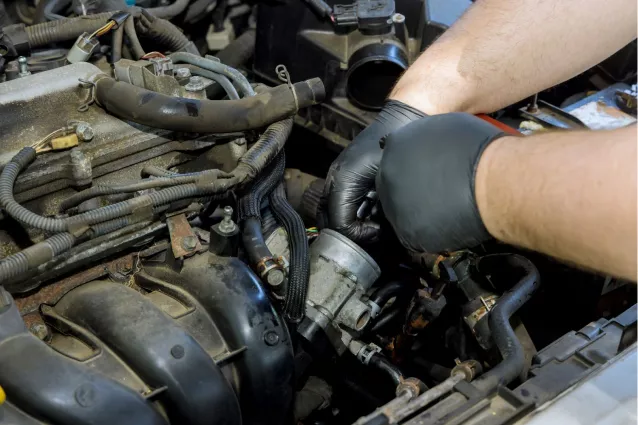The throttle position sensor (TPS) is a crucial component in a vehicle's engine management system. It is located on the throttle body and plays a significant role in optimizing engine performance and efficiency. Here are some key points about the throttle position sensor:

Function of Throttle Position Sensor (TPS):
-
Monitoring Throttle Position:
- The primary function of the TPS is to monitor the position of the throttle valve or butterfly in the throttle body.
- It detects how far the driver has pressed the accelerator pedal to adjust the air-fuel mixture and control engine speed accordingly.
-
Providing Feedback to Engine Control Unit (ECU):
- The TPS sends voltage signals to the engine control unit (ECU) based on the position of the throttle valve.
- This information allows the ECU to adjust fuel injection timing, ignition timing, and other parameters for proper engine operation.
-
Optimizing Fuel Efficiency and Performance:
- By accurately sensing the throttle position, the TPS helps the ECU optimize the air-fuel mixture, leading to improved fuel efficiency and engine performance.
Signs of a Faulty Throttle Position Sensor:
-
Check Engine Light:
- A malfunctioning TPS can trigger the check engine light on the dashboard.
-
Poor Engine Performance:
- Irregular engine idling, stalling, or hesitation during acceleration can be indicators of a faulty TPS.
-
Reduced Fuel Efficiency:
- A faulty TPS can cause the engine to run rich or lean, leading to decreased fuel efficiency.
-
Transmission Shifting Issues:
- Incorrect TPS readings can impact the transmission shift points, resulting in rough shifting or gear hunting.
Testing and Replacement:
- Testing the TPS:
- The TPS can be tested using a multimeter to check for smooth voltage changes as the throttle is opened and closed.
- Replacing the TPS:
- If the TPS is determined to be faulty, it should be replaced with a new one that is compatible with the vehicle make and model.
Importance of TPS:
The TPS is vital for maintaining efficient engine operation and performance by providing accurate throttle position data to the engine control unit. Regular maintenance and timely replacement of a faulty TPS can help ensure smooth engine performance, fuel efficiency, and overall vehicle reliability.
Consequences of Disconnecting the Throttle Position Sensor
Disconnecting the throttle position sensor (TPS) in a vehicle can have various consequences on the engine's performance and drivability. Here are some potential effects of disconnecting the TPS:
-
Check Engine Light (CEL) Activation:
- Disconnecting the TPS will likely trigger the vehicle's onboard diagnostics system to illuminate the check engine light on the dashboard. This indicates that the ECU has detected a fault in the TPS circuit.
-
Reduced Engine Performance:
- Without the input from the TPS, the engine control unit (ECU) will not be able to accurately determine the position of the throttle valve. This can lead to poor engine performance, rough idling, and hesitation during acceleration.
-
Transmission Shifting Issues:
- The TPS information is crucial for the ECU to determine optimal transmission shift points. Disconnecting the TPS can result in erratic or delayed shifting, leading to a poor driving experience.
-
Fuel Efficiency Concerns:
- The ECU uses TPS data to calculate the correct air-fuel mixture for efficient combustion. With the TPS disconnected, the engine may run rich or lean, causing decreased fuel efficiency and potentially damaging the catalytic converter.
-
Throttle Response Problems:
- Disconnecting the TPS can lead to irregular throttle response as the ECU may not be able to adjust the fuel and air intake properly based on driver input.
-
Emission Control System Issues:
- The TPS is essential for the proper functioning of the emission control system. Disabling the TPS can disrupt the system's operation, leading to increased emissions and potential non-compliance with environmental regulations.
-
Vehicle Stalling or Inability to Start:
- In extreme cases, disconnecting the TPS may cause the engine to stall or prevent the vehicle from starting altogether, especially if the ECU fails to receive crucial throttle position data.
In summary, disconnecting the throttle position sensor can have adverse effects on the vehicle's performance, drivability, and overall functionality. It is not recommended to disconnect the TPS unless it is necessary for troubleshooting purposes and the vehicle is not running. If you suspect issues with the TPS, it is advisable to diagnose and address the problem promptly to ensure the proper functioning of the engine and related systems.
Symptoms of a Bad Throttle Position Sensor
A failing or bad throttle position sensor (TPS) can lead to various symptoms that can affect the engine's performance and drivability. Here are some common signs to look out for that indicate a potential issue with the throttle position sensor:
1. Check Engine Light (CEL) Activation:
- The most common indicator of a faulty TPS is the illumination of the check engine light on the dashboard. The ECU detects irregularities in the TPS signal and triggers the warning light.
2. Poor Engine Performance:
- Irregular Idling: The engine may experience idling problems, such as idling too high or too low, or fluctuating RPMs when the throttle is not being pressed.
- Hesitation or Stalling: Inconsistent or delayed throttle response can lead to hesitation during acceleration, sputtering, or even stalling when driving.
3. Transmission Shifting Issues:
- A malfunctioning TPS can affect the transmission's shift points, leading to rough or delayed shifting, erratic gear changes, or harsh engagements.
4. Decreased Fuel Efficiency:
- A faulty TPS can disrupt the air-fuel mixture, causing the engine to run rich or lean. This can result in decreased fuel efficiency and increased fuel consumption.
5. Throttle Response Problems:
- Lack of Responsiveness: The vehicle may exhibit unresponsive or jumpy throttle behavior, especially during sudden acceleration or deceleration.
- Surging or Jerking: Sudden surges or jerks while driving, especially at consistent speeds, can indicate TPS issues.
6. Rough Idle and Poor Performance:
- The engine may idle rough or inconsistently, creating a noticeable vibration or shaking sensation in the vehicle.
7. Speed Fluctuations:
- The vehicle speed may fluctuate unexpectedly, even when driving at a steady pace.
8. Delayed Shifts and Harsh Transmission Engagements:
- Issues with the TPS can impact the transmission's ability to shift smoothly, resulting in delayed or harsh gear changes.
9. High or Low Idle Speeds:
- The engine may idle at higher or lower speeds than normal when the throttle is released, leading to potential drivability issues.
10. Acceleration Problems:
- Difficulty in accelerating smoothly, lack of power, or sluggish acceleration can be attributed to a malfunctioning TPS.
If you notice any of these symptoms, it is advisable to have the throttle position sensor inspected and, if necessary, replaced by a qualified mechanic. Prompt diagnosis and repair of a faulty TPS can help prevent further engine issues and ensure optimal performance of your vehicle.
Why Should You Connect Throttle Position Sensor
Connecting the throttle position sensor (TPS) is essential for the proper operation of the vehicle's engine management system. Here are some key reasons why it is crucial to connect the throttle position sensor:
1. Engine Performance:
- The TPS provides vital information to the engine control unit (ECU) about the position of the throttle valve. This information is necessary for the ECU to adjust fuel injection timing, ignition timing, and other parameters to ensure optimal engine performance.
2. Fuel Efficiency:
- By accurately sensing the position of the throttle valve, the TPS helps the ECU optimize the air-fuel mixture. This leads to efficient combustion and improved fuel efficiency.
3. Throttle Response:
- Proper connection of the TPS ensures smooth and responsive throttle operation. The ECU relies on TPS data to regulate throttle response accurately based on driver input.
4. Transmission Shifting:
- The TPS information is crucial for determining optimal transmission shift points. Connecting the TPS helps the ECU control the transmission's gear shifts, ensuring smooth and timely changes.
5. Idling Stability:
- An operational TPS helps maintain stable engine idling. Correct throttle position data allows the ECU to adjust idle speed accurately, preventing rough idling or stalling.
6. Emission Control:
- Proper TPS connection is necessary for the effective operation of the vehicle's emission control system. This ensures compliance with environmental regulations and reduces harmful emissions.
7. Diagnostic Purposes:
- Connecting the TPS enables the ECU to monitor the throttle position and detect any irregularities or faults in the sensor. This information can be used for troubleshooting and diagnosing engine performance issues.
8. Prevention of Engine Damage:
- Maintaining a functional TPS connection helps prevent potential engine damage or performance problems that may arise from inaccurate throttle position readings.
9. Overall Vehicle Safety:
- Ensuring that the TPS is properly connected contributes to the safe operation of the vehicle by maintaining reliable engine performance and drivability.
10. Compliance with Manufacturer Specifications:
- Vehicle manufacturers design their systems to operate optimally when all components, including the TPS, are connected as intended. Following manufacturer guidelines and maintaining proper connections ensures optimal vehicle performance.
In summary, connecting the throttle position sensor is crucial for ensuring efficient engine operation, optimal fuel delivery, smooth throttle response, and overall vehicle performance. Failure to connect the TPS can lead to a range of drivability issues and potential damage to engine components. It is recommended to always maintain proper sensor connections to support reliable and efficient vehicle operation.
Potential Risks of Disconnecting the Sensor
Disconnecting a sensor in any system can lead to various risks and consequences, depending on the specific sensor and its role in the overall operation. Here are some potential risks associated with disconnecting a sensor:
-
Engine Performance Issues:
- Disconnecting a critical sensor, such as the throttle position sensor (TPS) or mass airflow sensor (MAF), can result in poor engine performance, including rough idling, hesitation during acceleration, misfires, and reduced power output.
-
Loss of Safety Features:
- Sensors play a crucial role in modern vehicle safety systems, such as anti-lock braking systems (ABS), traction control systems (TCS), and stability control systems. Disconnecting sensors related to these safety features can compromise the vehicle's ability to operate safely in various driving conditions.
-
Increased Emissions:
- Sensors like oxygen sensors (O2 sensors) and catalytic converter temperature sensors help regulate emissions. Disconnecting these sensors can lead to increased emissions, potential damage to the catalytic converter, and non-compliance with emission standards.
-
Poor Fuel Efficiency:
- Sensors like the oxygen sensor and MAF sensor contribute to optimizing fuel efficiency by adjusting the air-fuel mixture. Disconnecting these sensors can lead to decreased fuel efficiency and increased fuel consumption.
-
Vehicle Stalling or Inoperability:
- Disconnecting certain sensors may cause the vehicle to stall, hesitate, or refuse to start. Critical sensors like the crankshaft position sensor or camshaft position sensor are essential for engine operation and timing.
-
Increased Wear on Engine Components:
- Running a vehicle with disconnected sensors can lead to abnormal operation, potentially causing increased wear on engine components, such as the pistons, valves, and cylinders, due to improper fuel delivery or timing.
-
Risk of Fire or Damage:
- In extreme cases, disconnecting certain sensors, especially those related to fuel injection or pressure regulation, can pose a risk of fuel leaks, engine overheating, or other issues that may lead to a fire or engine damage.
-
Reduced Performance and Driveability:
- Disconnecting sensors that provide essential data to the engine control unit (ECU) can result in reduced overall vehicle performance, compromised driveability, and an unpleasant driving experience.
In conclusion, disconnecting sensors in a vehicle can have serious consequences on engine performance, safety features, emissions compliance, fuel efficiency, and overall drivability. If there are issues with a sensor, it is recommended to diagnose and address the problem promptly rather than disconnecting the sensor, to ensure the proper functioning of the vehicle's systems and components.



